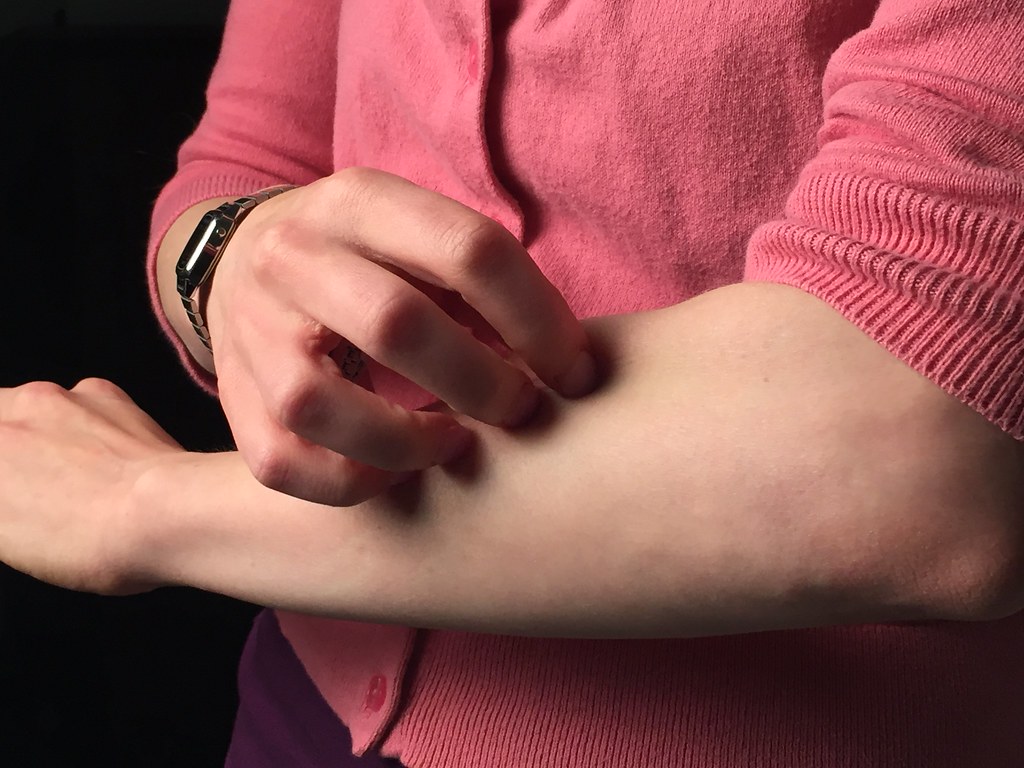Dermatillomania also known as excoriation disorder or chronic skin-picking is a mental illness related to obsessive-compulsive disorder. It is characterized by repeated picking at one’s own skin which results in skin lesions and causes significant disruption in one’s life.
Individuals may pick at healthy skin, minor skin irregularities (e.g., pimples or calluses), lesions, or scabs. This disorder is usually chronic, with periods of remission alternating with periods of greater symptom intensity. If untreated, skin-picking behaviors may come and go for weeks, months, or years at a time. It is common for individuals with this disorder to spend significant amounts of time, sometimes even several hours a day, on their picking behavior.
Skin picking is a body-focused repetitive behavior (BFRB) that typically begins during adolescence, commonly coinciding with, or following the onset of, puberty around ages 13-15, but may also occur among children (under 10 years old), or adults (between the ages of 30 and 45). Excoriation disorder affects approximately 1.4% of American adults, and is experienced by women more often than men.
Most people pick at their skin from time to time, but you may have skin picking disorder if you:
- cannot stop picking your skin
- cause cuts, bleeding or bruising by picking your skin
- pick moles, freckles, spots or scars to try to “smooth” or “perfect” them
- do not always realize you’re picking your skin or do it when you’re asleep
- pick your skin when you feel anxious or stressed
You may pick your skin with your fingers, fingernails, teeth or with tools like tweezers, pins or scissors.
Causes of Dermatillomania (skin picking disorder)
Skin picking disorder is related to obsessive compulsive disorder, where the person cannot stop themselves carrying out a particular action.
It can be triggered by:
- boredom
- stress or anxiety
- negative emotions, such as guilt or shame
- skin conditions, such as acne or eczema
- other blemishes that the person wants to get rid of (these may not be noticeable to other people)
It’s sometimes called a body-focused repetitive behavior and is similar to repetitive hair pulling disorder (trichotillomania).
What are the signs & symptoms of dermatillomania?
Dermatillomania is currently classified as an “obsessive-compulsive and related disorder” in the Diagnostic and Statistical Manual of Mental Disorders, Fifth Edition (DSM-5).
The DSM-5 diagnostic criteria include:
- Recurrent skin picking that results in skin lesions
- Repeated attempts to stop the behavior
- The symptoms cause clinically significant distress or impairment
- The symptoms are not caused by a substance or medical, or dermatological condition
- The symptoms are not better explained by another psychiatric disorder
Those who engage in skin picking tend to pick from multiple body sites, for extended periods of time, targeting both healthy and previously damaged skin. Targeted areas of the body may change over time. Commonly reported experiences that lead to picking include: an urge or physical tension prior to picking, unpleasant emotions, cognitions (permission-giving thoughts, beliefs about how the skin should look or feel), sensations (a bump, sore spot), and/or a displeasing aspect of one’s own appearance (visible blemish). Commonly reported experiences following picking behavior include: urge reduction, sense of relief or pleasure, psychosocial difficulties or embarrassment, avoidance, reduced productivity, emotional sequelae such as anxiety or depression, skin infections, scars, lesions, and/or disfigurement.
Although the severity of excoriation disorder varies greatly, many people who struggle with skin picking exhibit noticeable skin damage, which they attempt to camouflage with makeup, clothing, or other means of concealing affected areas. Due to shame and embarrassment, individuals may also engage in avoidance behaviors, including the avoidance of certain situations that may lead them to feel vulnerable to being “discovered” (e.g., wearing shorts, being seen by others without makeup, or intimacy).
Due to the nature of skin picking, it is important to consider whether the behavior is characteristic of excoriation disorder, or, whether it is better accounted for by another psychiatric disorder which warrants treatment. For example, skin picking may be a symptom of a dermatological disorder, an autoimmune disorder, body dysmorphic disorder, obsessive-compulsive disorder, substance abuse disorder (e.g., opiate withdrawal), developmental disorder (e.g., autism spectrum disorder), or psychosis. Comprehensive evaluation and accurate diagnosis is important in determining an appropriate treatment plan.
Impact & Effects of Dermatillomania
The impact of skin picking disorder on one’s life may be significant. Individuals may experience shame and embarrassment, and as a result, may avoid certain social situations or activities (e.g., pools, gyms, beaches), and medical care. These emotional sequelae can lead to painful isolation and result in a great deal of emotional distress, placing them at risk for a co-occurring psychiatric disorder, such as a mood or anxiety disorder. Furthermore, these individuals often go to great lengths to cover, hide, or camouflage damaged skin and may have difficulty with time management due to the significant time involved in engaging in the behavior as well as efforts to conceal it.
Medical complications as a result of excoriation disorder are not uncommon. Infection, which may require medical treatment, scabbing, open wounds, discoloration, scarring, or disfigurement are possible consequences of chronic skin picking behavior. Skin picking can also lead to strained relationships with family members and friends. Family members may need professional help in coping with this problem.
How do you stop dermatillomania?
According to Harvard health, these four tips can help you tackle your picking. They include:
Knowing your triggers: You may be tempted to pick for a variety of reasons, from boredom, itch, or negative emotions, to blemishes or simply looking at or feeling your skin. You may even find the experience of picking itself pleasurable. Understanding your triggers can be a first step in deciding which treatments to pursue. For example, if your picking is triggered by a skin condition such as acne or itch, you might be best served by first seeing a dermatologist. If, however, your picking is triggered by depression, anxiety, or more of an urge, you should consult with a mental health professional with expertise in skin picking.
Making it harder to pick: One simple strategy to reduce picking, called stimulus control, involves changing your environment to make it harder to pick. Examples of this technique include keeping your nails short, wearing gloves at times when you are most likely to pick, and making the skin more difficult to access by wearing tight-fitting clothing or long-sleeve shirts. You can also try distracting your hands with any number of items including silly putty, stress balls, fidgets, and tangle toys. Once you have found an item that works for you, make sure to have one everywhere you spend time such as work, home, and your bag, so you are fully covered.
Get therapy: Cognitive behavioral therapy (CBT) is a structured type of psychotherapy that aims to produce healthier behaviors and beliefs by identifying unhelpful thoughts and behaviors. A specialized type of CBT has been developed for SPD. This type of CBT includes more of the stimulus control techniques described above, as well as habit reversal training, in which individuals are taught to engage in a harmless motor behavior (like clenching one’s fists) for one minute when triggered to pick. Clinical trials have demonstrated that skin-picking for CBT can be extremely effective. But because it is different than other types of CBT, it will be important to work with a therapist who is trained in treating SPD. You can find skin-picking experts at the TLC Foundation for Body-Focused Repetitive Behaviors.
Consider medication with your providers: While no medication has been formally approved by the FDA to treat excoriation disorder, there is evidence to suggest that selective serotonin reuptake inhibitor (SSRI) antidepressants and N-acetylcysteine (NAC), an antioxidant supplement, can be helpful.
Please be aware that even over-the-counter, well-tolerated supplements like NAC should always be taken under the supervision of a medical professional for guidance on dosing, duration of treatment, drug interactions, and side effects.
For more on overcoming SPD, visit the TLC Foundation for Body-Focused Repetitive Behaviors and the International OCD Foundation.





